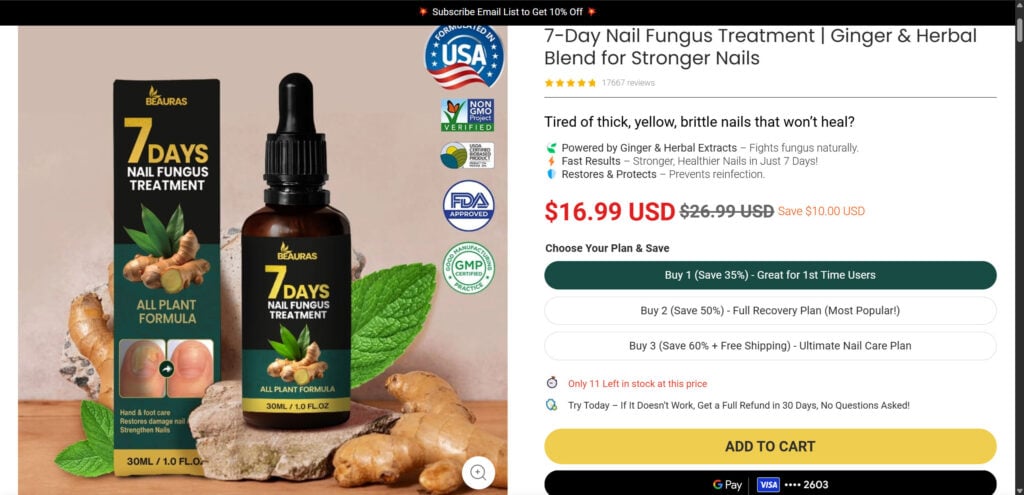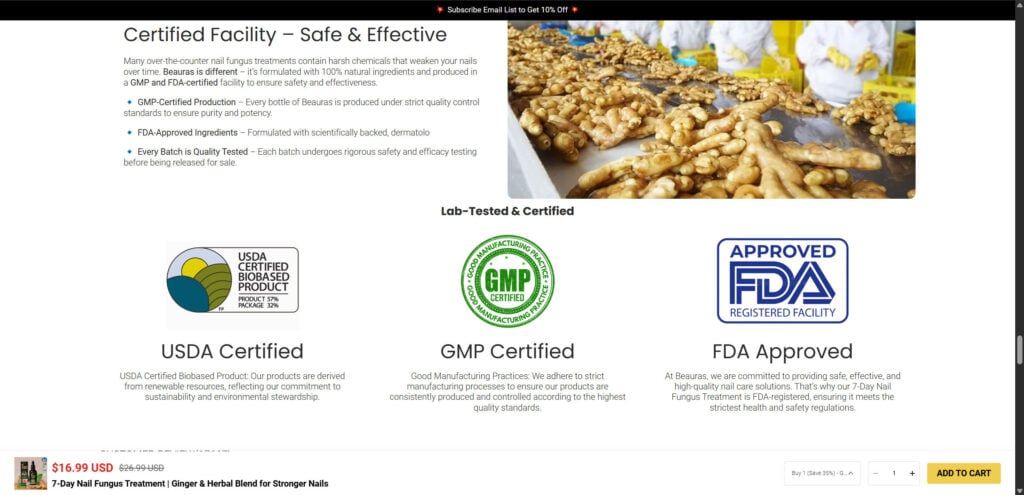Lately, you’ve probably seen ads and glowing reviews for Beauras Nail Fungus Treatment, claiming miraculous results in just 7 days and boasting over 50,000 satisfied customers. It sounds impressive, almost too good to be true. But when you start digging, questions begin to surface. Can a nail fungus treatment really work that fast? Is Beauras as trustworthy as it seems—or is it just another cleverly marketed scam?
In this comprehensive exposé, we’ll take you through the red flags, deceptive tactics, and false promises behind Beauras. By the end, you’ll know whether it’s safe to hit “Add to Cart” or walk away.

Overview
Beauras markets its 7-Day Nail Fungus Treatment as a natural miracle: ginger, turmeric, tea tree oil, and other plant extracts, all designed to destroy fungal infections without side effects. According to their site, this concoction delivers stronger, healthier nails in just one week. Sounds appealing, right?
But here’s the first problem: nail fungus is a notoriously difficult condition to treat. Even the most potent oral antifungals prescribed by dermatologists take months to show visible results. The idea that a topical, herbal oil blend can eliminate fungus in a mere 7 days is, frankly, medically improbable.
Domain Registration Date: The Smoking Gun
A quick WHOIS search reveals that the Beauras website was registered on February 6, 2025. Yet the brand claims to have over 50,000 verified users, glowing reviews, and “clinically tested” success rates. How could a product that’s only been on the market for weeks have already built such an extensive customer base?
It’s not just unlikely—it’s logistically impossible.
Fake Authority and Misleading Labels
The Beauras website features badges that say “FDA Approved,” “GMP Certified,” and “USDA Organic.” These logos give the impression that Beauras is officially regulated. However, the FDA does not approve over-the-counter herbal cosmetics or essential oil treatments. While GMP certification can apply to facilities, it does not confirm the efficacy or safety of the actual product. Worse, the USDA certification badge refers only to the biobased packaging, not the formula itself.
Additionally, the featured doctor endorsement on the product page uses a stock photo. A reverse image search confirms that the image has appeared in various unrelated contexts online, and there is no trace of the doctor’s credentials, license number, or real identity.
No Evidence of Clinical Trials
One of Beauras’s bolder claims is that its product is “clinically proven.” But if you look for peer-reviewed research, published data, or trial documentation, you won’t find any. Not a single link to an academic journal or study exists on their site. The cited statistics like “94% saw improvements in 7 days” are completely unsubstantiated.
Inflated Testimonials and Trust Badges
The website features numerous reviews, most of them overly enthusiastic and suspiciously similar in tone. There are no timestamps or verified user profiles. Testimonials with dramatic “before and after” images are commonly recycled from stock photo libraries.
And despite claiming FDA and USDA approval, there is no trace of Beauras in any official FDA or USDA database.

In short, Beauras hides behind a curtain of false trust signals and unrealistic promises. It markets aggressively through fake endorsements, bogus stats, and pseudoscientific claims—all the hallmarks of a classic online scam.
How the Scam Works
Step 1: Targeting the Desperate
Beauras leverages paid ads across social media platforms to reach individuals struggling with chronic nail fungus. Their messaging is tailored to evoke urgency and desperation, often using phrases like “Finally a cure that works” or “Doctors hate this trick.”
Step 2: Building Illusion of Trust
When users click the ad, they land on a polished e-commerce page filled with:
- “FDA approved” and “GMP certified” badges
- Fake testimonials
- Fabricated clinical success rates
- A fake doctor endorsement
- Claims of 100% natural and safe ingredients
All of these elements are carefully curated to build false credibility and instill buyer confidence.
Step 3: Pressuring the Purchase
Beauras creates urgency through tactics like:
- Flash sales
- Countdown timers
- Claims of “Only 11 left at this price”
- Promises of “Free shipping”
- Money-back guarantees (which are rarely honored)
Buyers are pushed to purchase quickly, often without reading the fine print.
Step 4: Collecting Payment
Once you proceed to checkout, the payment gateway accepts all major forms of payment. But once the transaction goes through, what happens next can vary:
- You might receive the product, but it’s often ineffective or different from what’s described.
- In some cases, users report being enrolled in recurring payment plans without consent.
- Refund requests are ignored or stalled by vague customer support emails.
Step 5: Vanishing Act
If enough negative reviews pile up or fraud reports surface, the Beauras site can simply disappear, only to rebrand and relaunch under a new name a few weeks later.
Step 6: Exploiting Legal Loopholes
Because Beauras is marketed as a “natural remedy,” it avoids strict regulation. That makes it harder for authorities to crack down, and easier for the scammers to continue operations under different branding.
What to Do If You’ve Fallen Victim to the Scam
If you suspect you’ve been scammed by Beauras, take these steps immediately:
- Contact Your Bank or Credit Card Company
- Request a chargeback.
- Explain that you believe the purchase was fraudulent.
- Report the Scam
- File a complaint with the Federal Trade Commission (FTC): reportfraud.ftc.gov
- Report to the Better Business Bureau (BBB) if the business is listed.
- Report to your local consumer protection agency.
- Cancel Recurring Payments
- If you notice multiple charges, cancel your card and request a new one to stop unauthorized billing.
- Warn Others
- Leave honest reviews on scam reporting sites and forums.
- Share your experience on social media or relevant Facebook groups.
- Monitor for Identity Theft
- Keep an eye on your bank accounts, credit card activity, and email for suspicious activity.
- Consult a Dermatologist
- If you have nail fungus, seek legitimate medical advice. Avoid experimenting with unverified products.
Frequently Asked Questions (FAQ) About Beauras Nail Fungus Treatment
Is Beauras Nail Fungus Treatment FDA approved?
No. Despite displaying an “FDA Approved” badge, Beauras is not officially approved by the U.S. Food and Drug Administration. The FDA does not regulate or approve over-the-counter herbal or cosmetic treatments in the same way it does pharmaceuticals. The use of this badge on their site is misleading.
How long has Beauras been in business?
The Beauras website was registered on February 6, 2025, according to WHOIS data. This contradicts their claim of having tens of thousands of verified users, suggesting either inflated or fabricated customer numbers.
Does Beauras really cure nail fungus in 7 days?
Medically speaking, it is highly unlikely. Nail fungus typically requires weeks or even months of consistent treatment, often involving prescription medication. There is no clinical evidence to support Beauras’ claim of full recovery in just 7 days.
Are the ingredients in Beauras safe?
Beauras lists natural ingredients like ginger extract, tea tree oil, turmeric, and vitamin E. While these ingredients are generally considered safe in small amounts, their effectiveness in treating nail fungus is limited and not clinically proven.
Is Beauras clinically tested?
There are no published clinical trials or peer-reviewed studies confirming the effectiveness of Beauras. Their claims of “clinically proven” results appear to be unsubstantiated marketing language.
Are the testimonials on the Beauras site real?
Most likely not. Many testimonials use stock images or overly generic language. There is no visible verification system for reviews, and no independent third-party review platform is linked.
What should I do if I’ve already ordered Beauras?
If you believe you’ve been misled:
- Contact your credit card company to dispute the charge.
- Report the seller to the FTC.
- Monitor your account for recurring payments or unauthorized charges.
- Seek medical advice from a qualified healthcare provider if you have ongoing nail issues.
Does Beauras offer a money-back guarantee?
While the site claims a 30-day refund policy, many users report difficulties in getting responses from customer service or receiving a refund. Approach such guarantees with caution.
Is Beauras a scam?
Based on the red flags—misleading claims, fake endorsements, lack of clinical data, and questionable business practices—Beauras appears to fit many of the criteria associated with online health product scams. Consumers should exercise extreme caution.
The Bottom Line
Beauras Nail Fungus Treatment may present itself as a revolutionary solution, but the evidence points to a deceptive marketing scam. From false FDA claims to fake reviews and an impossibly young website, every element raises red flags.
In reality, curing nail fungus takes time, consistency, and medical-grade treatments. Quick-fix promises are rarely what they seem. If you value your health and your money, skip Beauras and consult a qualified healthcare provider instead.
Stay informed, stay skeptical, and always research before you click “buy.”










